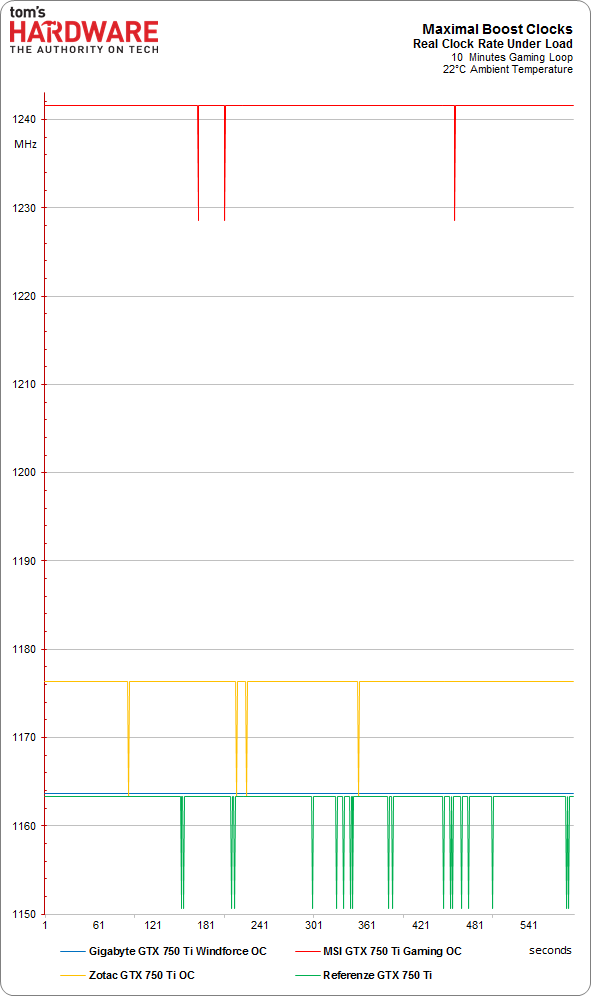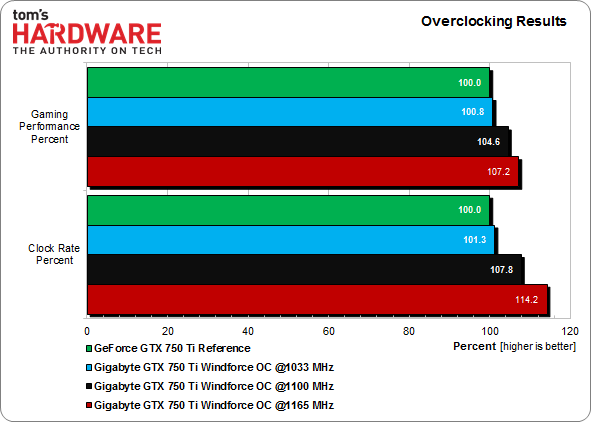GeForce GTX 750 Ti Review: Maxwell Adds Performance Using Less Power
GPU Boost And Overclocking
Factory Clock Rates and GPU Boost
We already know that the base clock rate of Nvidia's GPUs isn't indicative of what those processors can run at under load thanks to the company's GPU Boost technology, so long as certain conditions are met.
Base and GPU Boost frequencies can be set in firmware by board partners. So, depending on the card and its cooler, you might see varying Boost ceilings, even between products with the same base clock. In the following chart, Gigabyte posts the most conservative ceiling. However, it's able to sustain a frequency that does not fluctuate. The other three boards, lacking auxiliary power connectors, do bounce around more.
Overclocking? Yes, But Only A Little
After long stability tests using the partner cards, we settled on ~1.3 GHz as the highest usable GPU Boost clock rate. At that point, the power limit was intervening fairly restrictively. Unfortunately, this limit is set to 100%. Until Nvidia fixes whatever is preventing higher power targets, it won't be possible to push the board harder (up to the PCI Express slot's 75 W ceiling).
In terms of performance, the Gigabyte and MSI boards fare similarly. The GTX 750 Ti Gaming OC does manage to push higher peak clock rates, but then has to dial back more often due to the TDP limit. Gigabyte's offering delivers more rounded behavior. It also operates at an incredibly-cool 46 °C, despite our overclocked settings.
First, we'll compare base clock rate settings to observed GPU Boost frequencies:
It's clear that as you push overclocked frequencies higher, the card steps in more often to dial back down. In reality, this means you don't get a ton of benefit in real-world gaming. Let's compare the increased frequencies to the corresponding frame rates in Metro: Last Light and Crysis 3, which we normalize and average together.
Roughly 14%-higher base clock rate (11% GPU Boost) yields about 7% more gaming performance. Power consumption barely budges though, and the GeForce GTX 750 Ti continues respecting its TDP limit. Short-term peaks (102%) are countered immediately with a clock rate reduction. But by capping the power limit to 100%, we end up with fairly modest gains, regardless of whether more power is available through a six-pin connector or not. Nvidia needs to fix its software-imposed ceiling before we're able to push higher.
Get Tom's Hardware's best news and in-depth reviews, straight to your inbox.
Current page: GPU Boost And Overclocking
Prev Page Average Performance And Performance Per Watt Next Page GPGPU: Floating-Point Performance


